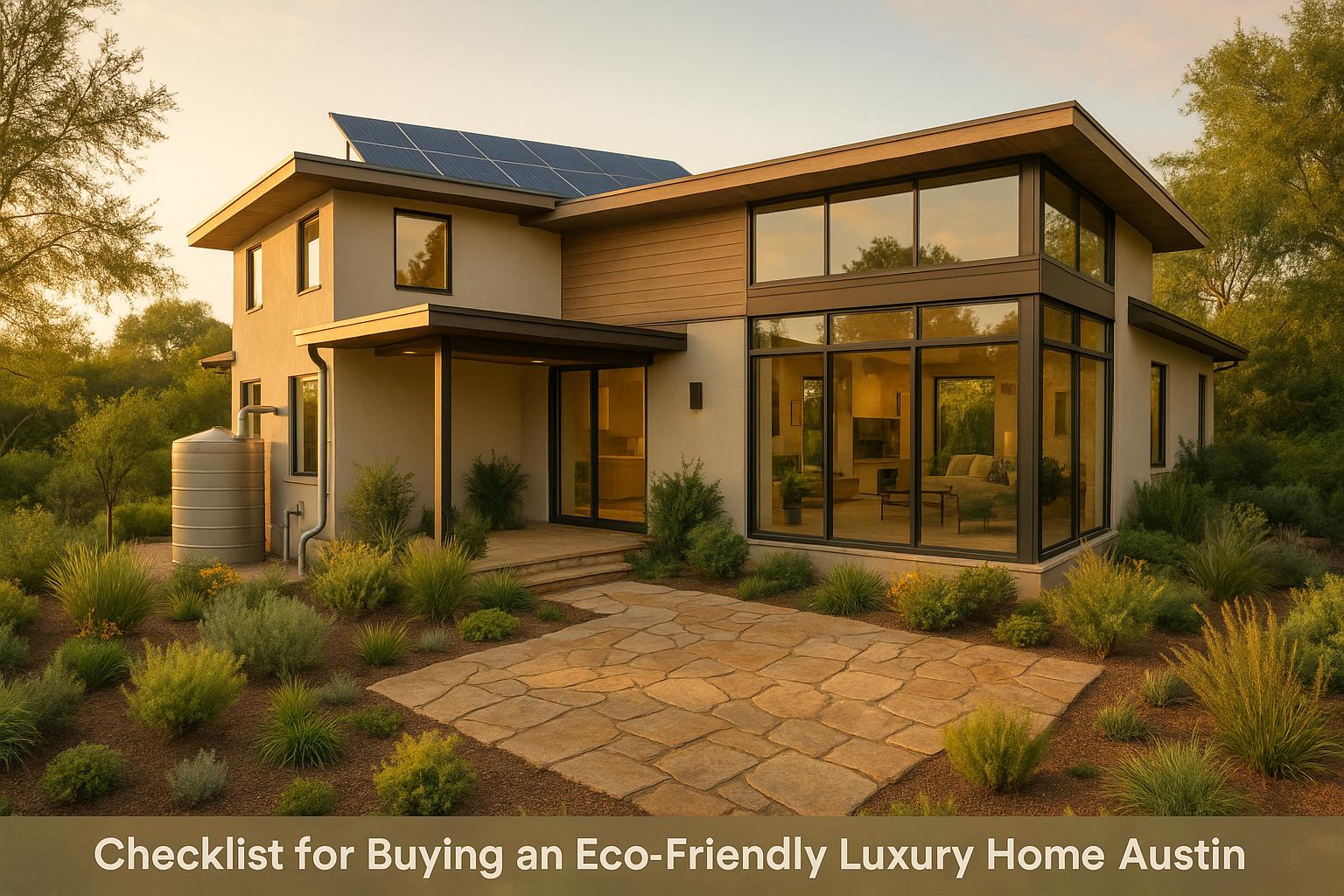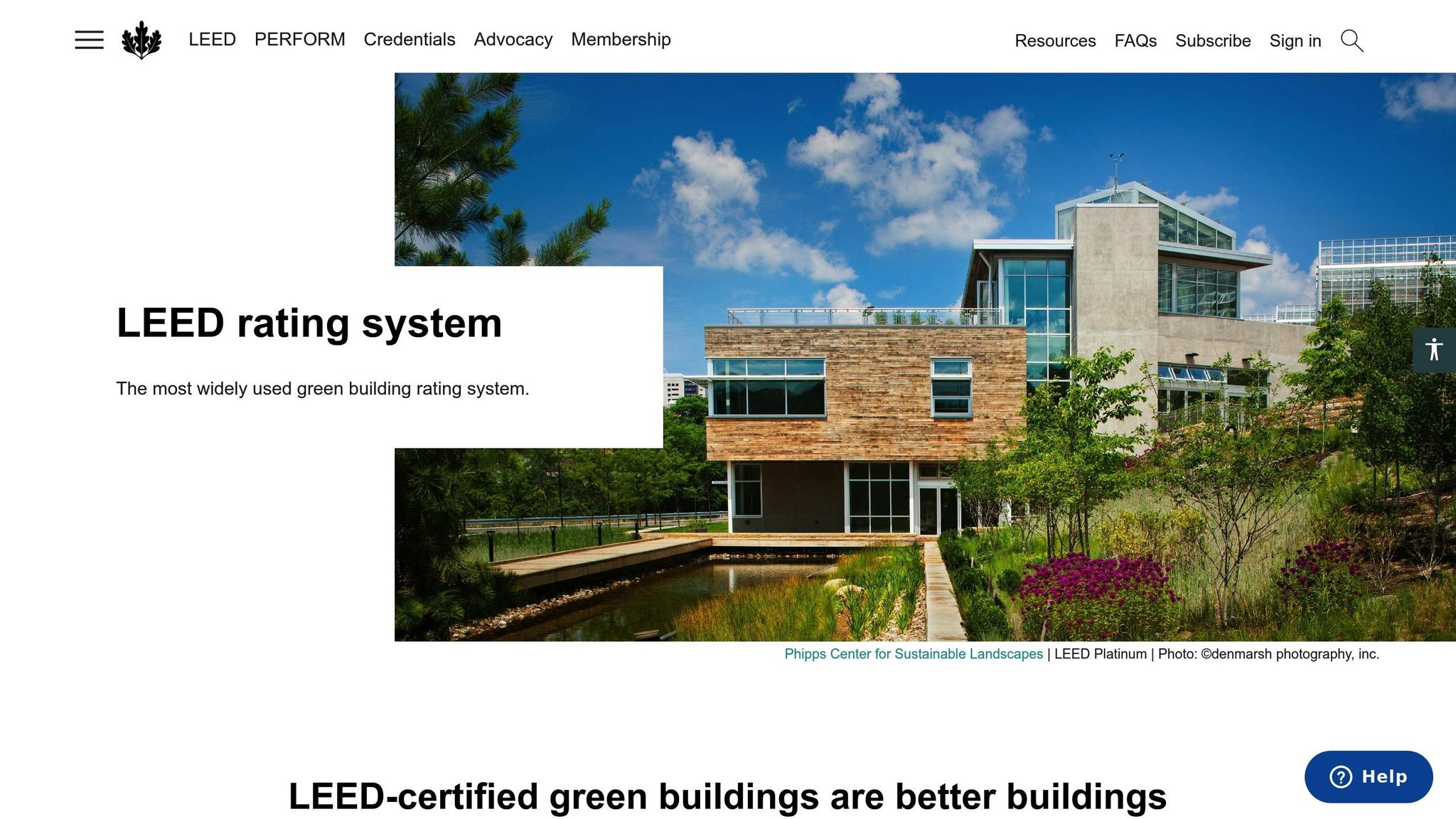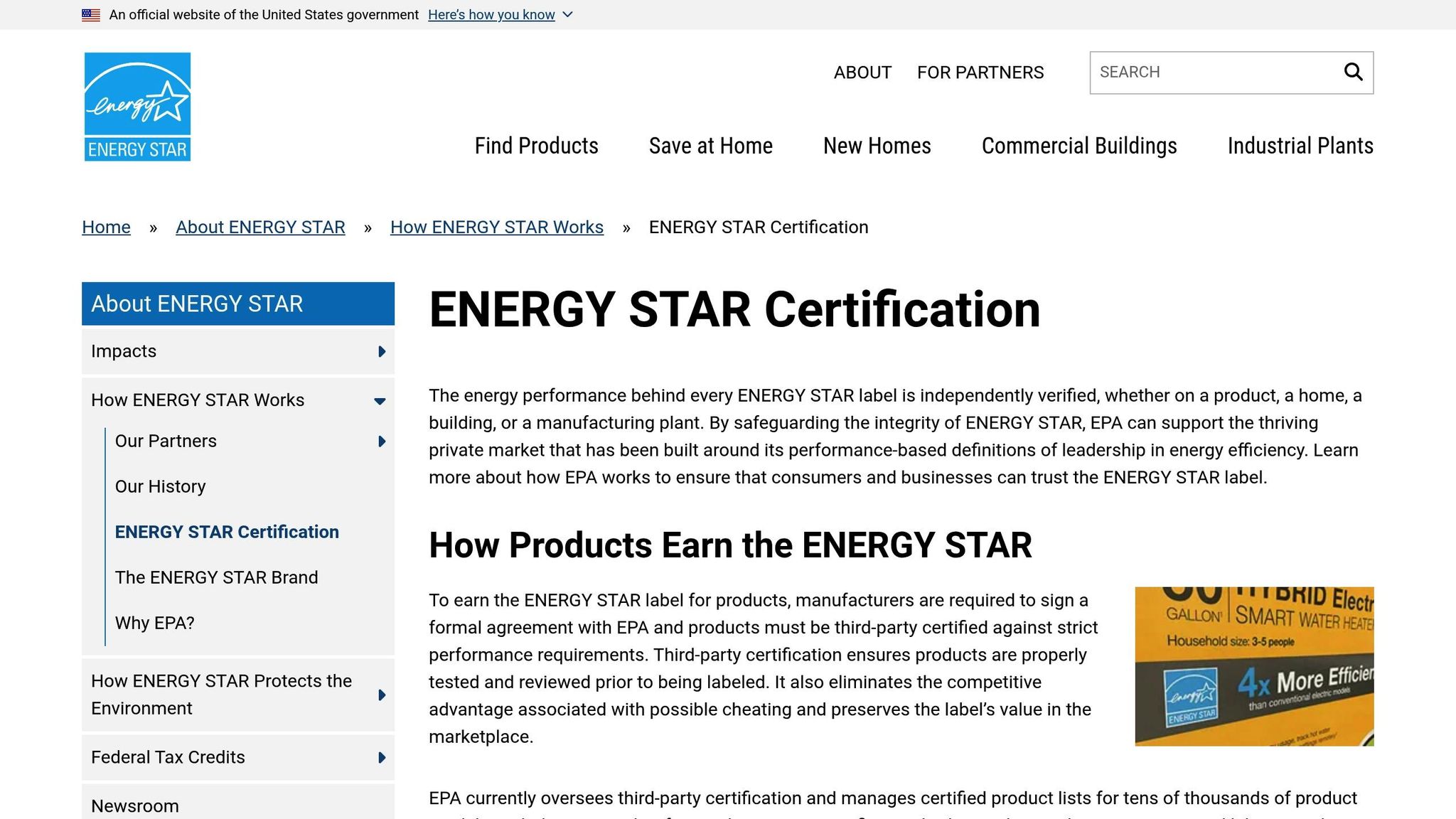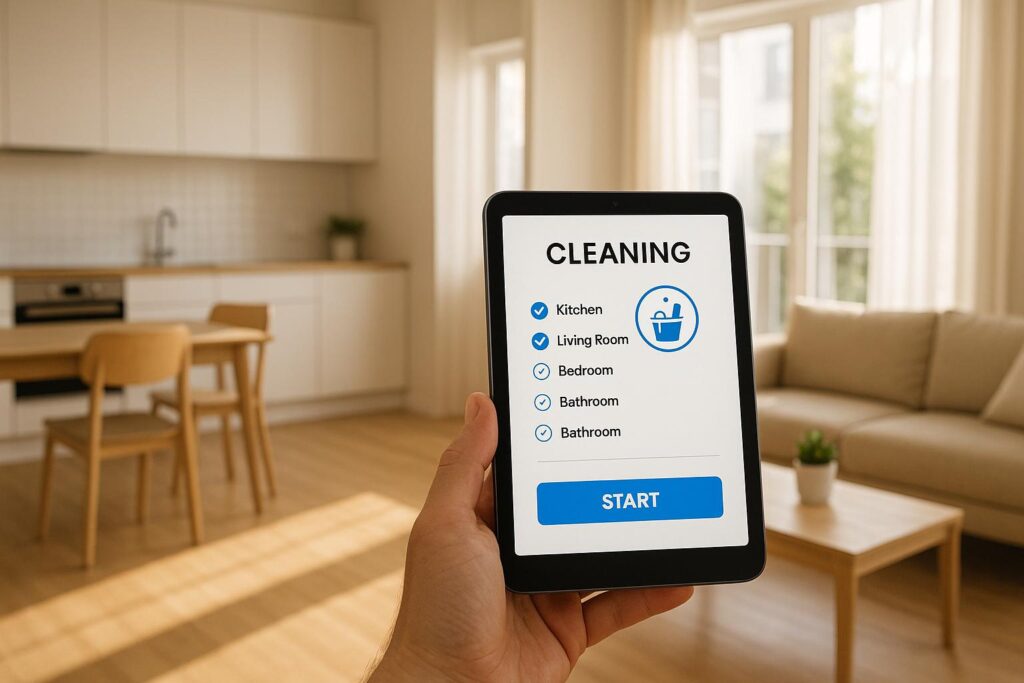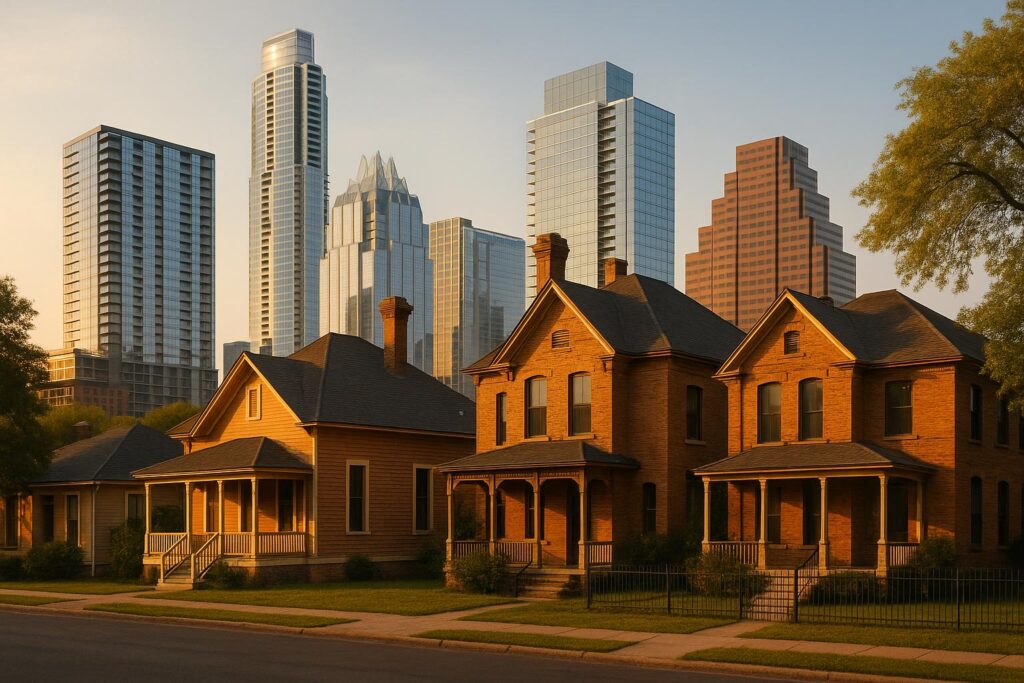- Energy Efficiency: Look for smart climate controls, high-performance windows, advanced insulation, and energy monitoring systems.
- Water Conservation: Prioritize homes with rainwater harvesting, gray water systems, and low-flow fixtures.
- Sustainable Materials: Choose homes built with recycled surfaces, sustainable wood, and low-VOC finishes.
- Certifications: Focus on properties with LEED, AEGB, ENERGY STAR, or NGBS certifications for verified green standards.
- Performance Checks: Review utility bills, HERS scores, and insulation quality for energy performance.
- Location Matters: South-facing homes with smart positioning for natural airflow and solar potential are ideal in Austin’s climate.
Quick Comparison of Green Certifications
| Certification | Focus Areas | Benefits |
|---|---|---|
| LEED | Energy, water, materials, air quality | 20–30% energy cost savings |
| AEGB | Localized energy and water standards | Tailored for Austin area |
| ENERGY STAR | Windows, HVAC, thermal enclosures | 10% lower energy bills |
| NGBS | Whole-house sustainability | Bronze to Emerald ratings |
Tip: Work with green-certified experts to find a home that aligns with your sustainability goals.
How You Can Design Your Home to be More Sustainable
Must-Have Green Features in Luxury Homes
When evaluating eco-friendly luxury homes in Austin, it’s important to look for sustainable features that promote energy savings and enhance comfort over time.
Energy-Saving Components
Luxury homes often include systems designed to minimize energy use while maintaining a comfortable living environment. Here are some key features to look for:
- Smart Climate Control: Thermostats that learn your preferences and adjust heating and cooling automatically for maximum efficiency.
- High-Performance Windows: Double or triple-pane windows with low-emissivity coatings to help regulate indoor temperatures.
- Enhanced Insulation: Top-grade insulation materials that go beyond standard requirements to conserve energy.
- LED Lighting: Lighting solutions that use less electricity without compromising brightness.
- Energy Monitoring Systems: Smart home technology that tracks energy use in real time, helping homeowners identify areas for improvement.
Next, consider water systems and building materials that align with sustainable living principles.
Water Systems and Building Materials
Efficient water systems and eco-conscious building materials are also critical for creating a sustainable luxury home. Here are some essential water-saving features:
| Feature | Description |
|---|---|
| Smart Irrigation | Weather-based systems that adjust outdoor watering schedules automatically. |
| Rainwater Harvesting | Systems that collect and store rainwater for landscaping and other uses. |
| Gray Water Systems | Reuse household water for irrigation, reducing overall water waste. |
| Low-Flow Fixtures | Faucets and showerheads designed to cut water use without losing performance. |
For building materials, focus on options that are both eco-friendly and durable:
- Sustainable Wood: Responsibly sourced timber for flooring, cabinetry, and more.
- Recycled Surfaces: Materials like recycled glass or stone for countertops and backsplashes.
- Low-VOC Finishes: Paints and sealants that improve indoor air quality by reducing harmful emissions.
- Cool Roofing: Reflective roofing materials that help lower heat absorption and keep homes cooler.
These features should be seamlessly integrated into the home’s overall design for maximum impact.
Green Building Certifications Guide
Explore the key certifications for green buildings. These certifications confirm energy efficiency, water conservation, indoor air quality, and the use of eco-friendly materials. They also serve as benchmarks for comparing homes and understanding their long-term environmental impact.
LEED and AEGB Programs
The Leadership in Energy and Environmental Design (LEED) certification is a widely recognized standard for eco-friendly construction. LEED-certified luxury homes are assessed on factors like energy efficiency, water-saving measures, air quality, and the use of sustainable materials. These criteria provide buyers with a consistent way to evaluate properties with an environmental focus.
The Austin Energy Green Building (AEGB) program is designed specifically for Central Texas. It uses a star rating system to score homes on energy performance, rainwater management, water-efficient landscaping, waste-reducing construction practices, and durable design features. This localized program helps homeowners and buyers in the region make informed choices.
ENERGY STAR and NGBS Ratings
Homes with ENERGY STAR certification are equipped with high-performance windows, well-sealed thermal enclosures, and efficient HVAC systems. These features are verified through rigorous testing to ensure optimal energy performance.
The National Green Building Standard (NGBS) certification takes a whole-house approach, rating homes on a scale from Bronze to Emerald. Luxury homes that achieve top-tier ratings meet strict standards for energy use, water conservation, construction waste reduction, and indoor air quality.
These certifications not only demonstrate a home’s environmental responsibility but also enhance its appeal in the Austin market.
Energy Performance Evaluation Steps
Power Usage and Equipment Check
Start by reviewing a full year of utility bills to understand energy consumption patterns. Also, verify the HERS (Home Energy Rating System) score to gauge the home’s energy efficiency. Focus on these systems:
- HVAC: Check for high-efficiency units.
- Water Heating: Look for ENERGY STAR-certified models.
- Smart Automation: Ensure programmable thermostats are installed and functioning.
After that, evaluate the insulation to confirm it supports effective energy retention.
Home Insulation Assessment
Use thermal imaging to identify gaps or leaks in the insulation. Pay close attention to these areas:
- Window and door seals
- Exterior wall penetrations
- Attic access points
- Ductwork seams
- Foundation sill plates
Many modern luxury homes use advanced insulation materials that provide better performance than older methods. To ensure minimal air leakage, request a blower door test report. This test can offer a clear picture of the home’s overall airtightness.
sbb-itb-4c99469
Austin Market Specifics
Property Position and Access
The way a home is positioned in Austin can greatly influence its energy efficiency. For instance, a south-facing home can take advantage of sunlight for warmth and make solar installations more effective. Proper orientation also supports natural airflow, which helps reduce the need for air conditioning during hotter months. Smart placement that incorporates shade can keep interiors cooler in summer. It’s equally important to choose a builder who has a proven ability to incorporate these design principles effectively.
Builder Track Record
When evaluating builders in Austin, it’s essential to review their experience with sustainable construction. Check how well they address the area’s unique weather patterns, such as maximizing energy efficiency during sunny periods and managing occasional heavy rains. Look for builders who prioritize eco-friendly features, like native landscaping and water-saving designs, and ensure they meet or exceed local environmental standards. These elements not only boost energy efficiency but also add long-term value to your property.
For expert guidance, consider consulting local professionals, such as the team at Austin Local Team. They can provide insights into builder reputations and help ensure your eco-friendly luxury home aligns with your sustainability goals.
Working with Green Home Experts
Finding an eco-friendly luxury home requires the right expertise. Partnering with agents who are knowledgeable about sustainable building practices, energy-efficient features, and green certifications can make your search smoother and help you make a well-informed decision.
Why Specialized Knowledge Matters
Agents with experience in green homes can offer insights on:
- How energy-efficient systems perform
- Local regulations for green construction
- Durability of sustainable materials
- Long-term upkeep and maintenance
- Potential for property value growth
Connections to Industry Professionals
These agents often have a network of experts, including energy inspectors, sustainable contractors, LEED consultants, solar panel installers, and green mortgage lenders. Their connections combine technical expertise with market knowledge, simplifying the process for you.
Understanding Market Trends
Experienced agents keep a close eye on local trends, especially in Austin’s luxury market. They know which eco-friendly features boost property values and can guide you toward homes that balance sustainability with investment potential.
"Austin Local Team was great! Extremely grateful for a real estate agent who was knowledgeable about issues moving from out of state. Good communication and setting expectations with deadlines." – Michael C.
Tailored Guidance for Your Needs
Start your search for an eco-friendly home with agents who align with your sustainability goals. Austin Local Team specializes in connecting buyers with experts in green luxury properties, ensuring both your environmental values and luxury preferences are met.
Support for Relocating Buyers
If you’re moving to Austin, working with local experts is even more important. They can provide guidance on:
- Sustainability efforts in specific neighborhoods
- Incentives and programs from local utility companies
- Community solar initiatives
- Green building codes
- Climate factors unique to the area
Checklist Summary
Here’s a streamlined checklist to turn the ideas above into practical steps:
Key Green Features
- Use ENERGY STAR®-rated appliances and HVAC systems for better efficiency.
- Install a solar panel system with battery storage and check if it qualifies for federal tax credits.
- Incorporate smart home technology to manage energy use effectively.
- Choose materials like low-VOC options and reclaimed wood for healthier indoor air and sustainability.
- Opt for permeable paving and native landscaping to reduce water usage by up to 50%.
Certification Details
| Certification | Benefits | How to Verify |
|---|---|---|
| LEED Platinum/Gold | Cuts energy costs by 20–30% | Check via USGBC database |
| AEGB 5-Star | Complies with local water standards | Confirm with Austin Energy |
| ENERGY STAR | Saves about 10% on energy bills | Review annual certification documents |
Performance Checkpoints
- Review 12–24 months of utility bills to assess energy use.
- Perform blower door testing (aim for ≤3 ACH50).
- Get a HERS Index score (target ≤50).
- Analyze solar production estimates for accuracy.
- Confirm insulation meets recommended R-values.
Location Factors
- Ensure the home is within 0.5 miles of CapMetro transit.
- Look for proximity to essential amenities like grocery stores and schools.
- Verify it’s outside 100-year floodplains.
- Check for a south-facing roof to maximize solar energy potential.
Team of Experts
- Work with a REALTOR® holding EcoBroker or NAR Green certification.
- Hire an ENERGY STAR HVAC specialist for system evaluations.
- Use a Certified Green Appraiser for accurate property valuation.
- Choose a sustainability-focused home inspector for a thorough review.
Financial Benefits
- Apply for the Austin Energy $2,500 solar rebate.
- Take advantage of a 10-year property tax exemption for renewable energy systems.
- Explore insurance discounts (average 18% for LEED-certified homes).
- Research green mortgage options for better financing terms.
- Check for local utility incentives offering up to $15,000.
FAQs
What certifications should you look for when buying an eco-friendly luxury home, and how do they help?
When purchasing an eco-friendly luxury home, look for certifications that verify the property’s sustainability, energy efficiency, and environmental impact. Key certifications include:
- LEED (Leadership in Energy and Environmental Design): Recognizes homes designed with sustainable materials, energy-efficient systems, and eco-conscious construction practices.
- ENERGY STAR: Indicates the home meets strict energy efficiency standards, reducing utility costs while minimizing environmental impact.
- National Green Building Standard (NGBS): Focuses on sustainable construction, water conservation, and improved indoor air quality.
These certifications ensure the property meets high standards for sustainability, offering long-term benefits like lower energy bills, a reduced carbon footprint, and a healthier living environment.
How can I determine if a luxury home’s eco-friendly features will provide long-term savings on energy and water bills?
To ensure that a luxury home’s eco-friendly features lead to long-term savings, start by evaluating key elements such as energy-efficient appliances, high-performance insulation, and water-saving fixtures. Look for certifications like LEED, Energy Star, or WaterSense, which indicate adherence to recognized efficiency standards. Additionally, review the home’s energy audit or utility history, if available, to gauge its current performance.
For further assurance, consider consulting a local real estate expert familiar with eco-friendly homes in Austin. They can help you identify properties that align with your sustainability goals and offer insights into potential cost savings over time.
What should I look for in a luxury home’s location in Austin to ensure it supports energy efficiency and sustainability?
When evaluating the location of a luxury home in Austin for energy efficiency and sustainability, consider a few key factors. Proximity to amenities like grocery stores, schools, and public transportation can reduce the need for long commutes, lowering your carbon footprint. Additionally, look for neighborhoods with green infrastructure, such as parks, bike trails, and tree-lined streets, which can improve air quality and provide natural cooling.
For enhanced energy efficiency, check if the property is oriented to maximize natural light and ventilation, as this can reduce reliance on artificial lighting and air conditioning. Homes in areas with access to renewable energy sources, such as solar-friendly zones, are also a significant plus. By focusing on these aspects, you’ll ensure your luxury home aligns with both eco-friendly living and sustainable practices.

